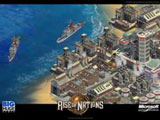 With the
release of Rise of Nations it looks like leaders of the strategy genre
are going to have to make room for a new player. Big Huge Games, the
company behind Rise of Nations, has struck gold by blending the best
aspects of turn based and real-time strategy gaming. The product is a
game that’s deep enough to hold you for hours, but retains the
approachability and pace of good real-time title. Nations has looked
good all through its production and the final copy is right in line.
With the
release of Rise of Nations it looks like leaders of the strategy genre
are going to have to make room for a new player. Big Huge Games, the
company behind Rise of Nations, has struck gold by blending the best
aspects of turn based and real-time strategy gaming. The product is a
game that’s deep enough to hold you for hours, but retains the
approachability and pace of good real-time title. Nations has looked
good all through its production and the final copy is right in line.
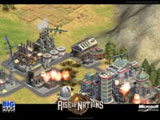 Right off
the bat you can see the close ties Rise of Nations shares with both the
Civilization series and the Age of Empires games. When you call this
game a hybrid, basically think of it as a middle road between those two
franchises. The buildings and units have that great detail you associate
with Age of Empires. As you zoom out, though, and get a look at the big
picture you know you are looking at something quite a bit deeper. Cities
dot the landscape for one thing. You also have roadways and trade routes
crisscrossing the terrain. You are not looking at a fort or even a
sprawling town, but a whole civilization.
Right off
the bat you can see the close ties Rise of Nations shares with both the
Civilization series and the Age of Empires games. When you call this
game a hybrid, basically think of it as a middle road between those two
franchises. The buildings and units have that great detail you associate
with Age of Empires. As you zoom out, though, and get a look at the big
picture you know you are looking at something quite a bit deeper. Cities
dot the landscape for one thing. You also have roadways and trade routes
crisscrossing the terrain. You are not looking at a fort or even a
sprawling town, but a whole civilization.
 This
becomes apparent as you progress through a scenario. Usually you start
out with only one city, a couple farms, and some citizens (peasants in
other games). As you build structures around your city it begins to take
on quite an identity. As your resources and knowledge grow you are able
to build more cities, which is where this idea of a civilization really
shines. One city may be more industrially inclined, being situated in
the foothills of a mountain where you grow food, mine minerals, and
collect timber. Another city down the road may become a center of
knowledge and religion, with libraries, universities, and a beautiful
mosque or cathedral. Yet another city is located on the coast and enjoys
a thriving maritime industry of fishing and naval activity. All of these
small and large cities come together to offer a rich and diverse
experience.
This
becomes apparent as you progress through a scenario. Usually you start
out with only one city, a couple farms, and some citizens (peasants in
other games). As you build structures around your city it begins to take
on quite an identity. As your resources and knowledge grow you are able
to build more cities, which is where this idea of a civilization really
shines. One city may be more industrially inclined, being situated in
the foothills of a mountain where you grow food, mine minerals, and
collect timber. Another city down the road may become a center of
knowledge and religion, with libraries, universities, and a beautiful
mosque or cathedral. Yet another city is located on the coast and enjoys
a thriving maritime industry of fishing and naval activity. All of these
small and large cities come together to offer a rich and diverse
experience.
 Rise of
Nations is a mechanically sound game, where all of those things I
described above happen in an organized fashion. As your resources grow
you can gain new knowledge on how to run your nation in four distinct
areas: militarily, civically, commercially, and scientifically.
Rise of
Nations is a mechanically sound game, where all of those things I
described above happen in an organized fashion. As your resources grow
you can gain new knowledge on how to run your nation in four distinct
areas: militarily, civically, commercially, and scientifically.
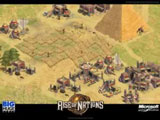 These
areas can be researched at any of your cities’ libraries and progression
within them yields great bonuses. For instance, the more military
research you do the more units you can create and the more advanced your
ability to make war becomes. Civic research leads to the ability to
build more cities and expands your nation’s borders. This is especially
important for two reasons. First of all most structures cannot be built
outside your nation’s borders. Secondly, in most situations you can win
a game by being the first to control 70% of the map. Borders may also
grow with the production of imposing military structures like castles.
Commercial research lets you harvest more resources and bolsters your
merchant fleet that travels between cities. This is important because
every time a trader enters a city you receive gold. Obviously more
traders means more coin for yours truly. Scientific research leads to
structures that enhance your efficiency like refineries, granaries, and
lumber mills. As your knowledge progresses you are able to further your
nation through the ages of time.
These
areas can be researched at any of your cities’ libraries and progression
within them yields great bonuses. For instance, the more military
research you do the more units you can create and the more advanced your
ability to make war becomes. Civic research leads to the ability to
build more cities and expands your nation’s borders. This is especially
important for two reasons. First of all most structures cannot be built
outside your nation’s borders. Secondly, in most situations you can win
a game by being the first to control 70% of the map. Borders may also
grow with the production of imposing military structures like castles.
Commercial research lets you harvest more resources and bolsters your
merchant fleet that travels between cities. This is important because
every time a trader enters a city you receive gold. Obviously more
traders means more coin for yours truly. Scientific research leads to
structures that enhance your efficiency like refineries, granaries, and
lumber mills. As your knowledge progresses you are able to further your
nation through the ages of time.
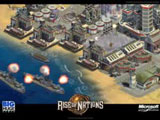 Age
progression is handled very well in Rise of Nations. Your nation is not
on a timer so you can feel free to stay in any of the eight timeframes
you like. Once you have researched enough of the required areas you are
able to enter the next age. Naturally you would not want to enjoy
looking at your Praetorian Guards too long, though, while your opponent
is developing machine guns and bazookas.
Age
progression is handled very well in Rise of Nations. Your nation is not
on a timer so you can feel free to stay in any of the eight timeframes
you like. Once you have researched enough of the required areas you are
able to enter the next age. Naturally you would not want to enjoy
looking at your Praetorian Guards too long, though, while your opponent
is developing machine guns and bazookas.
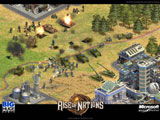 Something
you’ll also run into as you gain prominence is the ability to erect
wonders. Several are available to choose from depending on the timeframe
you are in such as the Roman Coliseum, the Eiffel Tower, or the Russian
Kremlin. Besides adding luster to your city, each wonder adds bonuses
like improved defense, faster troop movement, and improved line of
sight. Indeed these are important structures for they embody the second
form of bloodless victory available to you. Each scenario has a wonder
point requirement. Each wonder you build produces wonder points for your
nation. The first to reach the requirement automatically wins. Be
careful, though, because your opponent is notified anytime you attempt
to build a wonder and will no doubt do anything in his or her power to
hamper your project.
Something
you’ll also run into as you gain prominence is the ability to erect
wonders. Several are available to choose from depending on the timeframe
you are in such as the Roman Coliseum, the Eiffel Tower, or the Russian
Kremlin. Besides adding luster to your city, each wonder adds bonuses
like improved defense, faster troop movement, and improved line of
sight. Indeed these are important structures for they embody the second
form of bloodless victory available to you. Each scenario has a wonder
point requirement. Each wonder you build produces wonder points for your
nation. The first to reach the requirement automatically wins. Be
careful, though, because your opponent is notified anytime you attempt
to build a wonder and will no doubt do anything in his or her power to
hamper your project.
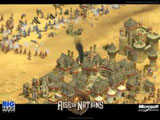 Even
though Rise of Nations offers a couple different ways to win without
firing a bullet, the game really shines during military conquest.
Players will command massive armies, navies, and later, air forces. The
unit allotment is huge in Rise of Nations and rightly captures the feel
of two actual countries clashing. Watching your troops march in battle
formation, line up and begin firing on ones another, then break up to
pursue opponents is cool, but to see it en masse is beautiful.
Even
though Rise of Nations offers a couple different ways to win without
firing a bullet, the game really shines during military conquest.
Players will command massive armies, navies, and later, air forces. The
unit allotment is huge in Rise of Nations and rightly captures the feel
of two actual countries clashing. Watching your troops march in battle
formation, line up and begin firing on ones another, then break up to
pursue opponents is cool, but to see it en masse is beautiful.
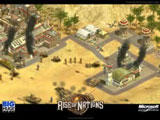 Armies
will be hotbeds of variety, too. Besides light and heavy infantry
players will eventually have access to machine gunners, flamethrowers,
special-forces commandos, spies, assassins, and generals. Rise of
Nations also supports unique units for each nation with special
abilities. Troops are supported by a full spread of armored units like
various tanks, artillery, and anti-air vehicles. The navy and air force
sport just as much variety. This all adds up to endless strategy of how
to mix and match forces as you send waves of troops to the front. With
the tools Big Huge Games is handing us we can stage full-scale campaigns
just like the real life nations today. That does include the threat of
nuclear war by the way.
Armies
will be hotbeds of variety, too. Besides light and heavy infantry
players will eventually have access to machine gunners, flamethrowers,
special-forces commandos, spies, assassins, and generals. Rise of
Nations also supports unique units for each nation with special
abilities. Troops are supported by a full spread of armored units like
various tanks, artillery, and anti-air vehicles. The navy and air force
sport just as much variety. This all adds up to endless strategy of how
to mix and match forces as you send waves of troops to the front. With
the tools Big Huge Games is handing us we can stage full-scale campaigns
just like the real life nations today. That does include the threat of
nuclear war by the way.
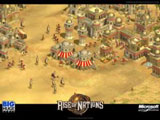 Rise of
Nations comes packed with an addictive single player campaign mode
fittingly dubbed "Conquer the World." You choose one of the 18 playable
nations then go to work on a screen resembles the board game Risk. You
are allotted territories at the beginning then go about moving troops to
stage conflicts. Each territory offers several incentives to its capture
with some offering more than others. A territory may contain a rare
resource like diamonds, textiles, or precious metals all of which give
your nation various bonuses. Territories may contain supply centers that
add to the amount of armies you control. Also you may find that a
territory holds a card. Each card offers a certain bonus that you may
enact before battles. Every territory pays some amount of tribute. The
game is round based, much like Risk. Instead of rolling dice to simulate
battle you figure it out using the real-time scenario that has been
described above. Also offered with Rise of Nations is a deep scenario
editor that you could spend equally as long with, even staging some of
the most famous battles in history.
Rise of
Nations comes packed with an addictive single player campaign mode
fittingly dubbed "Conquer the World." You choose one of the 18 playable
nations then go to work on a screen resembles the board game Risk. You
are allotted territories at the beginning then go about moving troops to
stage conflicts. Each territory offers several incentives to its capture
with some offering more than others. A territory may contain a rare
resource like diamonds, textiles, or precious metals all of which give
your nation various bonuses. Territories may contain supply centers that
add to the amount of armies you control. Also you may find that a
territory holds a card. Each card offers a certain bonus that you may
enact before battles. Every territory pays some amount of tribute. The
game is round based, much like Risk. Instead of rolling dice to simulate
battle you figure it out using the real-time scenario that has been
described above. Also offered with Rise of Nations is a deep scenario
editor that you could spend equally as long with, even staging some of
the most famous battles in history.
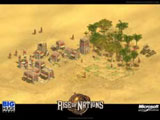 Rise of
Nations is a huge experience that will take you quite some time to fully
grasp and digest. Thanks to a user-friendly interface and solid gameplay
you’ll no doubt come back to it long after you’ve beat it. Why not the
fifth star then you ask? While Rise of Nations is an original and
engrossing experience, it does borrow much from two established
franchises. While you will no doubt enjoy yourself immensely, you
probably will not feel that you have entered the "uncharted waters" of a
trailblazing title. Still, even if you feel that this type of game has
been done before in one way or another, few can claim to have done it
better than Big Huge Games with Rise of Nations.
Rise of
Nations is a huge experience that will take you quite some time to fully
grasp and digest. Thanks to a user-friendly interface and solid gameplay
you’ll no doubt come back to it long after you’ve beat it. Why not the
fifth star then you ask? While Rise of Nations is an original and
engrossing experience, it does borrow much from two established
franchises. While you will no doubt enjoy yourself immensely, you
probably will not feel that you have entered the "uncharted waters" of a
trailblazing title. Still, even if you feel that this type of game has
been done before in one way or another, few can claim to have done it
better than Big Huge Games with Rise of Nations.
